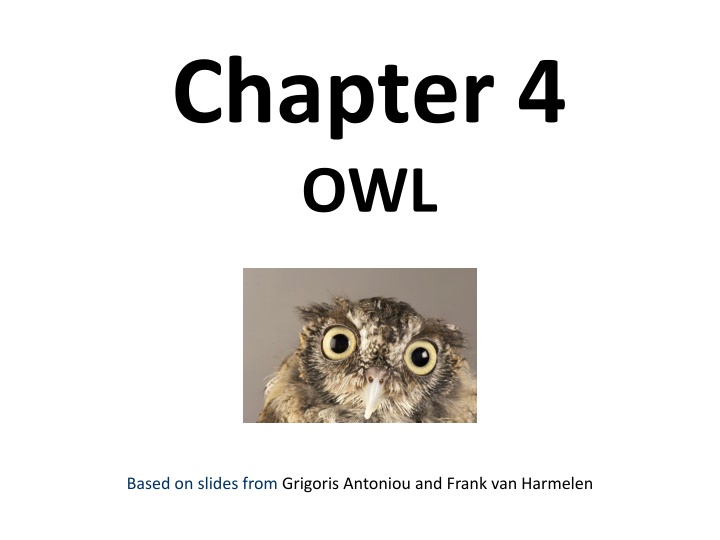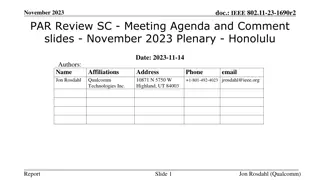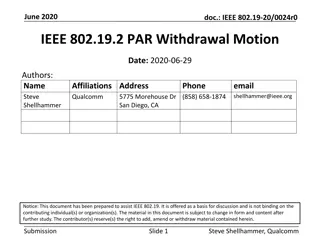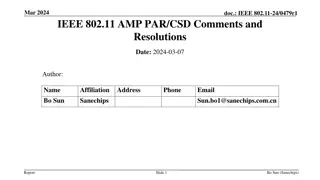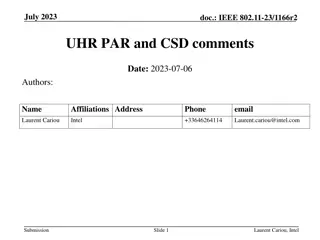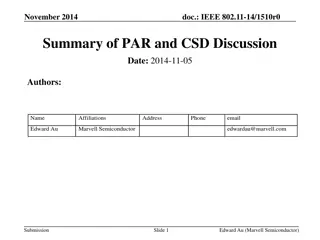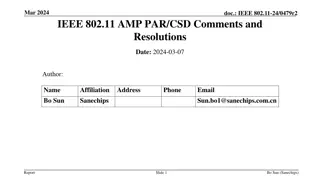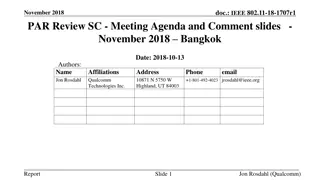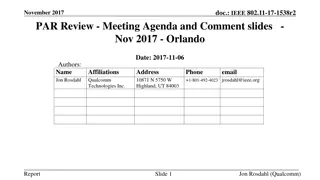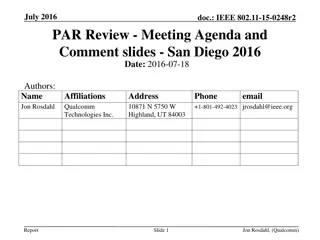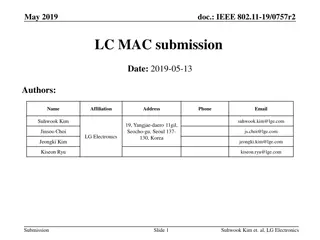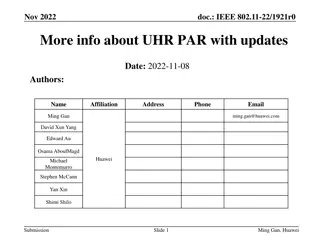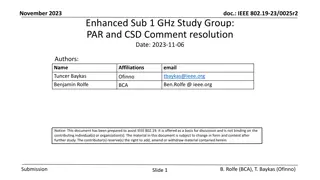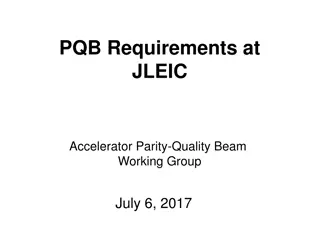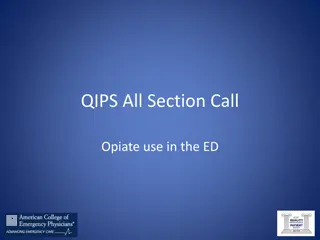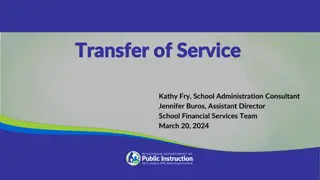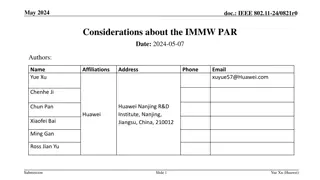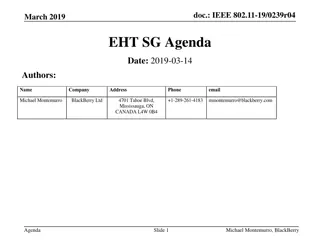IEEE 802.11-17-1538r1 PAR Review and Agenda Summary
Overview of the November 2017 PAR review meeting for IEEE 802.11-17-1538r1, including agenda details, motion approvals, and comments on various amendments related to wireless LAN and positioning technologies.
Uploaded on Mar 19, 2025 | 1 Views
Download Presentation

Please find below an Image/Link to download the presentation.
The content on the website is provided AS IS for your information and personal use only. It may not be sold, licensed, or shared on other websites without obtaining consent from the author.If you encounter any issues during the download, it is possible that the publisher has removed the file from their server.
You are allowed to download the files provided on this website for personal or commercial use, subject to the condition that they are used lawfully. All files are the property of their respective owners.
The content on the website is provided AS IS for your information and personal use only. It may not be sold, licensed, or shared on other websites without obtaining consent from the author.
E N D
Presentation Transcript
Chapter 4 OWL Based on slides from Grigoris Antoniou and Frank van Harmelen
TL;DR: What is OWL OWL defines new RDF predicates to RDF making it more expressive A knowledge representation language
Outline 1. A bit of history 2. Basic Ideas of OWL 3. The OWL Language 4. Examples 5. The OWL Namespace 6. OWL 2
The OWL Family Tree Logic Programming 1970s SHOE 1996 DAML RDF/RDF(S) DAML-ONT 1974 ~2000 Frames Joint EU/US Committee 2004 DAML+OIL OWL ~2000 OIL ~2002 Klone 1980 W3C OntoKnowledge+Others 1980s Description Logic
A Brief History of OWL: OWL W3C Recommendation (February 2004) Based on March 2001 DAML+OIL specification Well defined RDF/XML serializations Formal semantics First order logic Relationship with RDF Comprehensive test cases for tools/implementations RDF/RDF(S) DAML-ONT DAML+OIL OWL Frames OIL Growing industrial take up Description Logics
OWL 2 An extension of OWL Addressed deficiencies identified by users and developers (at OWLED workshop) Based on more expressive DL subset: SROIQ W3C working group chartered http://www.w3.org/2007/OWL/wiki/OWL_Workin g_Group Became W3C recommendation Oct. 2009 Supported by popular OWL tools Prot g , TopBraid, FaCT++, Pellet,
Outline 1. A bit of history 2. Basic Ideas of OWL 3. The OWL Language 4. Examples 5. The OWL Namespace 6. OWL 2
Ontology and Data Philosophy: Ontologies are models of what exists in the world (kinds of things, relations, events, properties, etc.) Information systems: a schema for info. or data KR languages: model of classes & relations/properties & associated axioms, e.g., subPropertyOf is transitive Data is information about individual instances expressed with terms in the ontology Some instances might be considered part of the ontology (e.g., God, George Washington, Baltimore)
Requirements for Ontology Languages Ontology languages let users write explicit, formal conceptualizations of domain models Requirements: well-defined syntax efficient reasoning support formal semantics sufficient expressive power convenience of expression
Expressive Power vs. Efficient Reasoning Always a tradeoff between expressive power and efficient reasoning support The richer the language, the more inefficient the reasoning support becomes (in general) Reasoning can be undecidable or semi-decidable and even if decidable can be exponentially hard We need a compromise between: Language supported by reasonably efficient reasoners Language that can express large classes of ontologies and knowledge
Kinds of Reasoning about Knowledge Class membership If x is an instance of a class C, and C is a subclass of D, then we can infer that x is an instance of D Equivalence of classes If class A is equivalent to class B, and class B is equivalent to class C, then A is equivalent to C, too Consistency X instance of classes A and B, but A and B are disjoint This is an indication of an error in the ontology or data Classification Certain property-value pairs are a sufficient condition for membership in a class A; if an individual x satisfies such conditions, we can conclude that x must be an instance of A
Uses for Reasoning Reasoning support is important for Deriving new relations and properties Automatically classifying instances in classes Checking consistency of ontology and knowledge checking for unintended relationships between classes Checks like these are valuable for designing large ontologies, where multiple authors are involved integrating and sharing ontologies from various sources
Reasoning Support for OWL Semantics is a prerequisite for reasoning support Formal semantics and reasoning support usually provided by mapping an ontology language to known logical formalism using automated reasoners that already exist for those formalisms OWL is (partially) mapped to a description logic DLs are a subset of logic for which efficient reasoning support is possible
RDFSs Expressive Power Limitations Local scope of properties rdfs:range defines range of a property (e.g., eats) for all instances of a class In RDF Schema we can t declare range restrictions that apply to only some E.g., animals eat living_things but cows only eat plants :eat rdfs:domain :animal; range :living_thing :eat rdfs:domain :cow; range :plant
RDFSs Expressive Power Limitations Disjointness of classes Sometimes we wish to say that classes are disjoint (e.g. male and female) Boolean combinations of classes Sometimes we want to define new classes by combining other classes using union, intersection, and complement E.g., person equals disjoint union of male and female classes E.g., weekdays equals set {:Monday, :Sunday}
RDFSs Expressive Power Limitations Cardinality restrictions E.g., a person has exactly two parents, a course is taught by at least one lecturer Special characteristics of properties Transitive property (like greater than ) Unique property (like is mother of ) A property is the inverse of another property (like eats and is eaten by
Combining OWL with RDF Schema Ideally, OWL would extend RDF Schema Consistent with the layered architecture of the Semantic Web But simply extending RDF Schema works against obtaining expressive power and efficient reasoning Combining RDF Schema with logic leads to uncontrollable computational properties OWL uses RDF and most of RDFS
Three Species of OWL 1 W3C sWeb Ontology Working Group defined OWL as three different sublanguages: OWL Full OWL DL OWL Lite Each sublanguage geared toward fulfilling different aspects of requirements
OWL Full It uses all the OWL languages primitives It allows the combination of these primitives in arbitrary ways with RDF and RDF Schema OWL Full is fully upward-compatible with RDF, both syntactically and semantically OWL Full is so powerful that it s undecidable No complete reasoning support
Soundness and completeness A sound reasoner only makes conclusions that logically follow from the input, i.e., all of its conclusions are correct We typically require our reasoners to be sound A complete reasoner can make all conclusions that logically follow from the input We cannot guarantee complete reasoners for full FOL and many subsets So, we can t do it for OWL Full
OWL DL OWL DL (Description Logic) is a sublanguage of OWL Full that restricts application of the constructors from OWL and RDF Application of OWL s constructors to each other is disallowed It corresponds to a well studied description logic OWL DL permits efficient reasoning support But we lose full compatibility with RDF Not every RDF document is a legal OWL DL document Every legal OWL DL document is a legal RDF document
OWL Lite An even further restriction limits OWL DL to a subset of the language constructors E.g., OWL Lite excludes enumerated classes, disjointness statements, and arbitrary cardinality The advantage of this is a language that is easier to grasp, for users implement, for tool builders The disadvantage is restricted expressivity
Outline 1. A bit of history 2. Basic Ideas of OWL 3. The OWL Language 4. Examples 5. The OWL Namespace 6. Future Extensions
OWL Syntactic Varieties OWL builds on RDF and uses RDF s serializations Other syntactic forms for OWL have also been defined: Alternative, more readable serializations
OWL XML/RDF Syntax: Header in Turtle @prefix owl: <http://www.w3.org/2002/07/owl#> . @prefix rdf: <http://www.w3.org/1999/02/22-rdf-syntax-ns#> . @prefix rdfs: <http://www.w3.org/2000/01/rdf-schema#> . @prefix xsd: <http://www.w3.org/2001/ XLMSchema#> . OWL documents are RDF documents and start with a typical declaration of namespaces The W3C recommendation for owl has the namespace http://www.w3.org/2002/07/owl#"
owl:Ontology <> a owl:Ontology ; rdfs:comment "Example OWL ontology" ; owl:priorVersion <http://example.org/uni-ns-old> ; owl:imports <http://example.org/persons> ; rdfs:label "University Ontology" . owl:imports, a transitive property, indicates that the document commits to all of the terms as defined in its target owl:priorVersion points to an earlier version of this document
OWL Classes :AssociateProfessor a owl:Class ; owl:disjointWith :Professor, :AssistantProfessor . Classes are defined using owl:Class owl:Class is a subclass of rdfs:Class Owl:Class is disjoint with datatypes (aka literals) Disjointness is defined using owl:disjointWith Two disjoint classes are can share no instances
Another Example :Man rdfs:subClassOf foaf:Person . :Woman rdfs:subClassOf foaf:Person . :Man owl:disjointWith :Woman . Questions: Is :Man an rdfs:Class or a owl:Class? Why don t we need to assert that :Man is some kind of class? Do we need to assert the disjointness both ways? What happens of we assert :bob a :Man; a :Woman?
OWL Classes :Faculty a owl:Class; owl:equivalentClass :AcademicStaffMember . owl:equivalentClass asserts two classes are equivalent Each must have the same members owl:Thing is the most general class, which contains everything i.e., every owl class is rdfs:subClassOf owl:Thing owl:Nothing is the empty class i.e., owl:NoThing is rdf:subClassOf every owl class
OWL Properties OWL has two kinds of properties Object properties relate objects to other objects owl:ObjectProperty, e.g. is-TaughtBy, supervises Data type properties relate objects to datatype values owl:DatatypeProperty, e.g. phone, title, age, These were made separate to make it easier to create sound and complete reasoners
Datatype Properties OWL uses XML Schema data types, exploiting the layered architecture of the Semantic Web :age a owl:DatatypeProperty; rdfs:domain foaf:Person; rdfs:range xsd:nonNegativeInteger .
OWL Object Properties Typically user-defined data types :isTaughtBy a owl:ObjectProperty; rdfs:domain :course; rdfs:range :AcademicStaffMember; rdfs:subPropertyOf :involves .
Inverse Properties :teaches a owl:ObjectProperty; rdfs:range :course; rdfs:domain :AcademicStaffMember; owl:inverseOf :isTaughtBy . Or just :teaches owl:inverseOf :isTaughtBy . A partial list of axioms: owl:inverseOf rdfs:domain owl:ObjectProperty; rdfs:range owl:ObjectProperty; a owl:SymmetricProperty. {?P owl:inverseOf ?Q. ?S ?P ?O} => {?O ?Q ?S}. {?P owl:inverseOf ?Q. ?P rdfs:domain ?C} => {?Q rdfs:range ?C}. {?A owl:inverseOf ?C. ?B owl:inverseOf ?C} => {?A rdfs:subPropertyOf ?B}.
Equivalent Properties :lecturesIn owl:equivalentProperty :teaches . Two properties have the same property extension Axioms { ?A rdfs:subPropertyOf ?B. ?B rdfs:subPropertyOf ?A.} <=> {?A owl:equivalentProperty ?B.}.
Property Restrictions Declare that class C satisfies certain conditions All instances of C satisfy the conditions This is equivalent to saying that C is subclass of a class C', where C' collects all objects that satisfy the conditions (C' can remain anonymous) Example: People whose sex is male and have at least one child whose sex is female and whose age is six Things with exactly two arms and two legs
Property Restrictions owl:Restriction element describes such a class Element has an owl:onProperty element and one or more restriction declarations One type defines cardinality restrictions A Parent must have at least one child :Parent rdfs:subClassOf [a owl:Restriction; owl:onProperty :hasChild; owl:minCardinalityQ "1"] .
Property Restrictions This statement defines Parent as any Person who has at least one child :Parent owl:equivalentClass owl:intersectionOf (:Person , [a owl:Restriction; owl:onProperty :hasChild; owl:minCardinalityQ "1 ])
Property Restrictions Other restriction types defines restrictions on the kinds of values the property may take owl:allValuesFrom specifies universal quantification owl:hasValue specifies a specific value owl:someValuesFrom specifies existential quantification
owl:allValuesFrom Describe a class where all of the values of a property match some requirement E.g., Math courses taught by professors. [a :mathCourse, [a owl:Restriction; owl:onProperty :isTaughtBy; owl:allValuesFrom :Professor] ].
Offspring of people are people foaf:Person a owl:Class; rdfs:subClassOf [ a owl:Restriction; owl:allValuesFrom foaf:Person; owl:onProperty bio:offspring ] .
Offspring of people are people foaf:Person a owl:Class; rdfs:subClassOf [ a owl:Restriction; owl:allValuesFrom foaf:Person; owl:onProperty bio:offspring ] . :john a foaf:Person; bio:offspring :mary
What follows? <foaf:Person> rdfs:subClassOf [owl:allValuesFrom <foaf:Person>; owl:onProperty <bio:offspring>] . ??? :bio:offspring rdfs:domain :animal; rdfs:range :animal. ??? :alice a foaf:Person; bio:offspring :bob. ??? :carol a foaf:Person. :don bio:offspring :carol. ???
What follows? <foaf:Person> rdfs:subClassOf [owl:allValuesFrom <foaf:Person>; owl:onProperty <bio:sprungFrom>] . bio:sprungFrom rdfs:domain :animal; rdfs:range :animal; owl:inverse bio:offspring. :carol a foaf:Person. :don bio:offspring :carol. ???
owl:hasValue Describe a class with a particular value for a property E.g., Math courses taught by Professor Longhair # Math courses taught by :longhair [ rdfs:subclassOf :mathCourse; [ a owl:restriction; owl:onProperty :isTaughtBy; owl:hasValue :longhair] . Questions: Does this say all math courses are taught by :longhair? Does it say that there are some courses taught by :longhair? Can all classes, however defined, by paraphrased by a noun phrase in English?
A typical example :Male owl:equivalentClass owl:intersectionOf (:Person, [a owl:Restriction; owl:onProperty :sex; owl:hasValue "male"] ).
A typical example :Male owl:equivalentClass owl:intersectionOf (:Person, [a owl:Restriction; owl:onProperty :sex; owl:hasValue "male"] ). :Person :Male :sex == male Classes are sets in OWL
What follows? :ed a :Male? ??? :frank a foaf:Person; :sex "male". ??? :gerry a foaf:Person; :sex "male"; :sex "female" .
owl:someValuesFrom Describe class requiring it to have at least one value for a property matching a description E.g., Academic staff members who teach an undergraduate course [ a :academicStaffMember; a [owl:onProperty :teaches; owl:someValuesFrom :undergraduateCourse] ]
Cardinality Restrictions We can specify minimum and maximum number using owl:minCardinality & owl:maxCardinality Courses with fewer than 10 students Courses with between 10 and 100 students Courses with more than 100 students Can specify a precise number by using the same minimum and maximum number Courses with exactly seven students For convenience, OWL offers also owl:cardinality E.g., exactly N
Cardinality Restrictions E.g. courses taught be at least two people [a owl:Restriction; owl:onProperty :isTaughtBy; owl:minCardinality 2 ^^xsd;nonNegativeInteger] .
